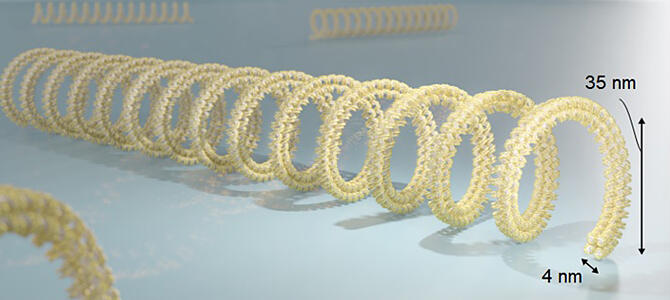A research group led by Senior Researcher Mitsuhiro Iwaki of the National Institute of Information and Communications Technology (NICT), in collaboration with RIKEN, has realized the world's smallest coiled spring using DNA as a material and achieved ultra-sensitive measurement of subtle forces on cells. This is the world's first measurement technique to detect the magnitude and orientation of noise-level forces on cells with subpicoNewton accuracy. (A picoNewton is one trillionth of a Newton.) This achievement is expected to significantly advance research toward clarifying the biomechanical information-processing mechanisms of living organisms. For instance, if the information-processing mechanisms of ultra energy-efficient mechanical forces in the brain and cells (which are still poorly understood) can be revealed, the development of computers based on entirely new principles will be possible. The results were published in the American scientific journal ACS Nano on July 2nd.

Credit: National Institute of Information and Communications Technology (NICT)
It is well known that living organisms process complex information using far less energy than that consumed by computers, and cells exchange information with each other using chemical molecules (e.g., neurotransmitters) and electricity. Recent discoveries have revealed that cells use mechanical forces as signals to exchange information.
Noise-level subtle forces are also detected with high sensitivity and undergo mechanical information processing; therefore, they are believed to contribute to ultra energy-efficient information processing. However, the underlying mechanism involved is not yet well understood.
One of the reasons for this poor understanding is the significant lack of techniques for measuring the subtle forces that cells sense with high sensitivity. The disadvantages of existing measurement techniques include their inability to accurately detect temporal (i.e., time-related) variations in subtle forces, narrow measurement ranges for force, and inability to simultaneously obtain information on the magnitude and orientation of the force with high temporal resolution.
In this study, the research group designed the world's smallest protein-sized coiled spring (nanospring) using DNA as a material, placed it between a cell and a glass substrate to link the two together, and succeeded for the first time in precisely measuring mechanical information (magnitude and orientation) of the subtle force on the cell with subpicoNewton accuracy.
In the experiments, the nanospring was designed to have a diameter of 35 nanometers (nm) and a length of 200-700 nm. One end of the nanospring was linked with an integrin molecule present on the cell membrane surface, while the other end was linked with the glass surface outside the cell. Integrins, which are proteins that exist on the cell surface, sense mechanical information by binding directly to extracellular substances (e.g., collagen), and they transmit this information to various molecules within the cell.
The nanospring was observed to stretch or contract when mechanical information was exchanged between the integrin molecule and the glass substrate. Variation in the orientation of stretching could also be observed simultaneously.
Furthermore, the research group could simultaneously measure temporal variations in the magnitude and orientation of the force by developing a new precise image analysis of these variations with nanometer accuracy. The measurement at nanometer resolution allowed for the easy detection of dynamic variations, including those of noise-level subtle forces (∼1 picoNewton).
This article was originally released in the July 21st edition of The Science News.
Journal Information
Publication: ACS Nano
Title: A Programmable DNA Origami Nanospring That Reports Dynamics of Single Integrin Motion, Force Magnitude and Force Orientation in Living Cells
DOI: 10.1021/acsnano.2c12545
This article has been translated by JST with permission from The Science News Ltd. (https://sci-news.co.jp/). Unauthorized reproduction of the article and photographs is prohibited.




